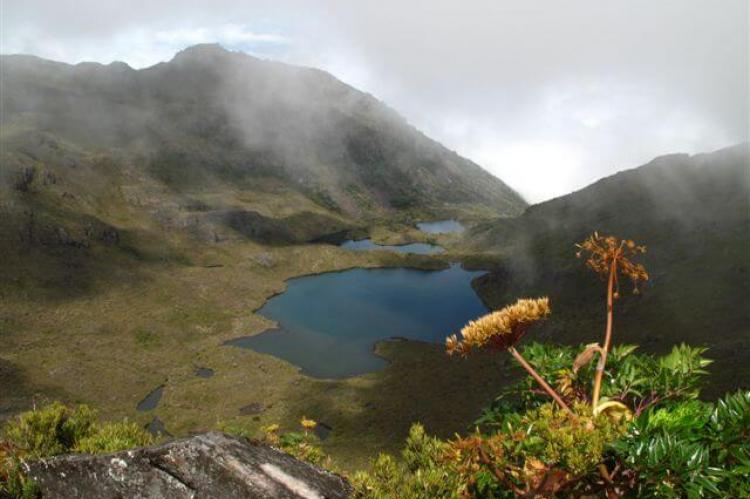The Costa Rican Páramo: A High-Altitude Wonderland
The Costa Rican páramo ecoregion is a unique landscape in the Cordillera de Talamanca, straddling Costa Rica and western Panama. It is a moist montane grassland and shrubland ecosystem that blurs the boundaries between alpine tundra and cloud forest, creating a delicate and resilient tapestry of life.
The Costa Rican Páramo: A High-Altitude Wonderland
Nestled within the towering peaks of the Cordillera de Talamanca, a mountain range that straddles the border between Costa Rica and western Panama, lies the Costa Rican páramo ecoregion. This unique and ethereal landscape stands as a testament to the incredible diversity of Central America's natural wonders. This moist montane grassland and shrubland ecosystem, often referred to as the Talamanca páramo, is a world unto itself, where the boundaries between alpine tundra and cloud forest blur, creating a delicate and resilient tapestry of life.
Defining the Páramo
A Diverse Ecosystem
The term "páramo" can refer to various alpine tundra ecosystems. Still, in Central America, it is classified explicitly as the high-altitude grasslands and shrublands found in the northern Andes of South America (Andean Moorland) and the southern regions of Central America, such as the Costa Rican páramo.
Altitudinal Zones
Within the Costa Rican páramo ecoregion, three distinct altitudinal zones can be identified:
1. Superpáramo: A narrow zone with scarce vegetation between the grass páramo and snow lines.
2. Páramo: It is dominated by grasses, rushes, herbs, and low shrubs from the families Gramineae, Asteraceae, Cyperaceae, Rosaceae, and Ericaceae.
3. Subpáramo: A dwarf forest dominated by the dwarf bamboo Chusquea subtessellata and short shrubs.
Surrounding Habitats
The páramo is surrounded by diverse forest habitats, including Atlantic slope rainforests, Pacific-slope seasonally dry (but mostly evergreen) forests, and cloud forests that cloak the mountain tops.
Surrounding the páramo at lower elevations are the Talamancan montane forests, which form an integral part of the region's ecosystem. These montane forests, characterized by their lush vegetation and diverse flora and fauna, contribute to the area's overall richness and biodiversity. Together with the páramo, they create a unique and interconnected landscape that supports a wide range of species and ecological processes.
A Unique Climate
The climate in the páramo ecoregion is typically characterized by its cool temperatures and high humidity due to its high-altitude location. Temperatures in the páramo can vary depending on the time of year and elevation, but they generally range from cool to cold, with temperatures often dropping below freezing at night. Precipitation is abundant throughout the year, contributing to the formation of the region's unique ecosystems, including the characteristic tussock grasslands and wetlands. Additionally, the páramo experiences frequent mist and fog, particularly in cloud forests, enhancing its moisture-rich environment and supporting diverse plant and animal life.
Biodiversity Hotspot
Flora
The Costa Rican páramo ecoregion is a true biodiversity hotspot. Over 30% of its flora, including more than 10,000 vascular and 4,000 non-vascular plant species, is endemic to the area. Abundant epiphytes cling to tree branches, while tree ferns are common.
Dominant tree groups in the region include the Lauraceae family and endemic oaks (Quercus spp.). The unique oak forests are characterized by majestic trees reaching up to 50 meters (164 feet) in height, heavily dominated by Quercus costaricensis and Q. copeyensis. The understory is further defined by several species of dwarf bamboo (Chusquea).
Fauna
The avian diversity of the Costa Rican páramo is equally impressive. More than half of the bird species found in the highlands of Costa Rica and western Panama are endemic to this region. Almost 85% of the species with restricted geographic ranges depend on forest habitats, with most of these being endemic to the Costa Rica-Chiriquí highlands.
Endemism among amphibians is also remarkably high, with at least seven small mammals considered regional endemics, further highlighting this ecosystem's unique and isolated nature.
Conservation Efforts
A Relatively Intact Habitat
The steep slopes and remoteness of the Costa Rican páramo ecoregion have limited human development impact, making it one of Central America's most intact habitats. This relative isolation has allowed the region's rich biodiversity to thrive, but it also highlights the importance of ongoing conservation efforts to protect this fragile ecosystem.
Preserving a Natural Wonder
As pressures from human activities, such as agriculture and tourism, continue to grow, it is essential to maintain and strengthen the existing protected areas within the páramo ecoregion. By safeguarding this unique and biologically diverse landscape, a natural wonder is preserved, ensuring the survival of countless endemic species that call this high-altitude haven home.
Conclusion
The Costa Rican páramo ecoregion is a true jewel in the crown of Central America's natural heritage, where the boundaries between tundra and cloud forest blur, creating a tapestry of life that is as unique as it is breathtaking. From its mist-shrouded grasslands and dwarf forests to its towering oak trees and diverse array of endemic species, this ecosystem is a reminder of the incredible diversity that thrives within our planet's most remote and rugged landscapes.
